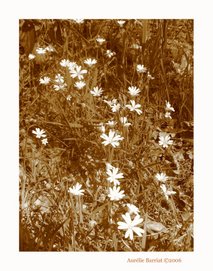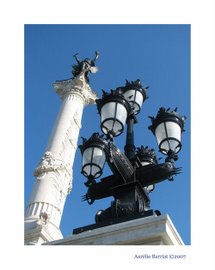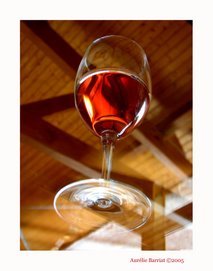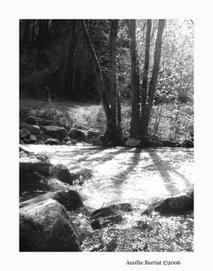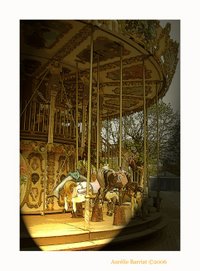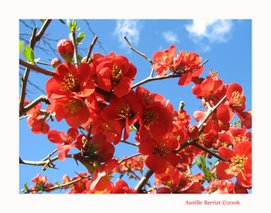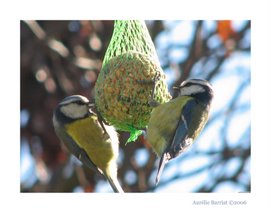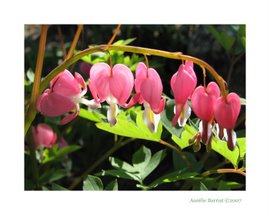Bibliographic reference
WILLEN BROWN, Stephanie. Indexing photographs [on line]. Springfield (Mass.): Union-News and Sunday Republican, Visual Edge '98 Archive Program, 4th September 2001. Available on: http://www.ibiblio.org/slanews/archiving/VE98/presentation.htm
Dublin Core
Title : Indexing photographs
Creator : Stephanie Willen Brown
Subject : newspaper photograph / indexing / keyword / free text
Description : It's about "newspaper photograph indexing, the use of keywords or free text to accomplish the indexing, and several examples of indexed newspaper pictures."
Publisher : http://www.ibiblio.org/
Date : 2001-12-04
Type : Conference
Format : HTML
Identifier : http://www.ibiblio.org/slanews/archiving/VE98/presentation.htm
Source : http://www.ibiblio.org/
Language : En
Relation : http://www.ibiblio.org/slanews/archiving/VE98/indexing.htm
Coverage : USA
Rights : Amy Disch
Extract
"Introduction
It is essential to have several ways to define the activity a photograph describes because describing the exact meaning of a picture is very difficult. When indexing works of art or music, this is especially tough, because only terms added by a librarian can be used to search the database. Newspaper photograph databases are easier to search because the cutline field is a wonderful source of information. The cutline usually has most of the information relevant to the image, including names of subjects, location, and a description of the activity.
In this presentation, I will (briefly!) discuss newspaper photograph indexing, the use of keywords or free text, and review several examples of indexed newspaper pictures. I have pulled 18 photographs from the Springfield Union-News to demonstrate how both keywords and free text indexing might be applied to a variety of situations.
Different Kinds of Searching
Searching the cutlines of hundreds of thousands of photographs to retrieve one of the principal of a grammar school would be relatively easy: the searcher – librarian, reporter, editor, photographer – would simply type in the name and a small number of photographs would likely be retrieved (assuming the person is not a trouble maker or married to a prominent figure). However, searching for an appropriate photograph of the mayor of the dominant city in a newspaper’s coverage area, Springfield in our case, would likely retrieve hundreds of images.
And what if you needed photographs of golf courses to accompany a story about the proliferation of golf courses in your area? You would have to remember the names of all the golf courses in the area and do a complicated, nested search. — Franconia, Crestview, the Orchards — You might forget the name of one or two of them, or you might retrieve photographs of events taking place at the "19th hole" of an area course.
A further curve thrown into the photo indexing mix is that different types of people — photographers, librarians, editors, and the general public — will need to search the database. Each group will need to retrieve different kinds of pictures:
o photographers might want to see if a particular scene had already been shot; (images of Taste of Holyoke, for example)
librarians would be looking for a photograph of a prominent politician;
Living/Arts editors might want a picture of last year’s big event (Shriner’s auto show) for an advance of this year’s event;
the general public might want a photograph of little Janey playing field hockey.
Indexing is the Answer
Applying subject terms to each photograph will greatly aid in retrieval. Ideally, each image will be assigned two to five subjects, addressing the central news aspect of the picture. This results in a richer description of a photograph. Indexers should add words that are not in the cutline to enhance the value of the subject field. A picture of a defendant in a murder trial, for example, would be assigned the keywords Murder and Trial. Either one used by itself is not enough to describe a photo of a defendant charged of murder who is on the witness stand, though both are correct and useful. But together, they accurately express the concepts demonstrated in the photograph.
Keywording vs. Free text
We will discuss two different ways of adding subject ideas to a photograph database: keywording and free text. I’ll describe, and show examples, of each.
"Keywording" refers to adding terms from a controlled vocabulary to a database of photographs to aid later retrieval. The most important component of keywording is the notion of a controlled vocabulary, a specific set of words from which index terms can be taken. Keywording is the a traditional means of indexing photographs, and is taught as Indexing in library school. A photograph of children on a swing, for example, might be given the keywords CHILD; PLAYING; and SUMMER.
"Free text" indexing, on the other hand, does not rely on a controlled vocabulary. Instead, it is more like free association: the indexer looks at the photograph and uses her imagination to describe what it is "about." A photograph of children on a swing, for example, could be "about" a hot summer afternoon; children or kids; swinging or playing; brothers, perhaps, if the children are related; smiling or laughing; and having fun."
Thursday, 25 January 2007
Saturday, 20 January 2007
Glossary English/French
Photography
Definition: “The art or process of producing images by the action of light on surfaces sensitized by chemical processes.”
Source: http://www.ncpublicschools.org/curriculum/artsed/scos/visualarts/vglossary
Photographie
Définition: "Ensemble des techniques permettant d'obtenir des images permanentes grâce à un dispositif optique produisant une image réelle sur une surface photosensible."
Source: Trésor de la langue Française
Librarianship
Definition: “The application of theories, principles, and techniques to the collection, preservation, organization, and use of recorded communications.”
Source: http://www.seattlecentral.org/faculty/jshoop/glossary.html
Bibliothéconomie
Définition: "Science, techniques et activités relatives à l'organisation, la gestion, la législation et la règlementation des bibliothèques."
Source: Vocabulaire de la documentation/ADBS. 2004.
Image processing
Definition: “Encompasses all the various operations which can be applied to photographic or image data. These include, but are not limited to image compression, image restoration, image enhancement, preprocessing, quantization, spatial filtering and other image pattern recognition techniques.”
Source: http://www.gaf.de/presshelp/glossary/p81.htm
Traitement d’image
Définition: "Ensemble de fonction de calcul et de manipulation d'images numériques visant à améliorer leur visualisation. Les principales fonctions sont la restauration d'images dégradées, l'amélioration de certaines caractéristiques (contraste, élimination du flou), la mise en valeur d'éléments spécifiques (recherche de contours ou de plages de couleur, calcul de surfaces) et la classification."
Source: Vocabulaire de la documentation/ADBS. 2004.
Still image
Definition: "Nonmoving visual information, i.e., fixed images, such as graphs, drawings, and pictures."
Source: http://www.atis.org/tg2k/_still_image.html
Image fixe
Définition: "Représentation généralement en 2 dimensions, opaque (par exemple estampe, dessin, épreuve photographique) ou translucide (par exemple diapositive, négatif), destinée à être regardé directement ou projetée sans mouvement à l'aide d'un instrument optique."
Source: Vocabulaire de la documentation/ADBS. 2004.
Physical document processing
Definition: "Methods, procedures and tools used to treat(handle), to arrange, to preserve and to store documents as support, whatever is this one. "
Source: Vocabulaire de la documentation/ADBS. 2004.
Traitement physique des documents
Définition: "Méthodes, procédures et outils utilisés pour traiter, ranger, conserver et stocker des documents en tant que support, quel que soit celui-ci."
Source: Vocabulaire de la documentation/ADBS. 2004.
Intellectual document processing
Definition: "census, classification, description."
Source: http://cat.inist.fr/?aModele=afficheN&cpsidt=2000296
Traitement intellectuel des documents
Définition: "Recensement, classement, description."
Source: http://cat.inist.fr/?aModele=afficheN&cpsidt=2000296
Image analysis
Definition: “Image analysis is the extraction of useful information from images; mainly from digital images by means of digital image processing techniques. Image analysis tasks can be as simple as reading bar coded tags or as sophisticated as identifying a person by its face.”
Source: http://en.wikipedia.org/wiki/Image_analysis
Analyse d'image
Définition: "L'analyse d'image a pour but d'extraire des informations qualitatives ou quantitatives d'une image ou d'un ensemble d'images. Cela requiert la mise en oeuvre et l'enchaînement d'un certain nombre de processus, comme l'identification des différents objets ou composants de l'image encore appelé segmentation, le calcul de leurs relations topologiques ou géométriques, l'estimation de mesures globales ou locales, et le cas échéant la caractérisation de ces objets."
Source: http://www.labri.fr/equipes/ImageSon/img_analyse/img_analyse.php
Picture indexing
Definition: “Automatic image annotation (also known as automatic image tagging) is the process by which a computer system automatically assigns metadata in the form of captioning or keywords to a digital image. This application of computer vision techniques is used in image retrieval systems to organize and locate images of interest from a database.”
Source: http://en.wikipedia.org/wiki/Automatic_image_annotation
Indexation d' image
Définition: "Représentation, par les éléments d'un langage documentaire ou naturel, des données résultant de l'analyse du contenu d'un document ou d'une partie d'un document, généralement en vue d'en faciliter la recherche."
Source: Grand dictionnaire terminologique
Picture digitization
Definition: “Transformation of analog data into digital data for computer storage and processing.”
Source: http://www.startphoto.com/learn/glossary/glossary_di-dn.htm
Numérisation d'image
Définition: "Transformation, en format numérique, d'une image enregistrée originalement sur une épreuve photographique."
Source: http://www.ccrs.nrcan.gc.ca/glossary/index_f.php?id=224
Image classification
Definition: “Image classification is the process of creating thematic maps from satellite imagery. A thematic map is an informational representation of an image which shows the spatial distribution of a particular theme. Themes can be as diversified as their areas of interest. Example of themes are soil, vegetation, water depth, and atmosphere. Inside a theme, there can be defined subthemes, and thus the process of classification needs to become more refined.”
Source: http://aria.arizona.edu/courses/tutorials/class/html/classwhyp1.html
Classification des images
Définition: "Action de distinguer par classes, par catégories, des documents selon un certain ordre."
Source: Grand dictionnaire terminologique
Picture retrieval
Definition : “An image retrieval system is a computer system for browsing, searching and retrieving images from a large database of digital images. Most traditional and common methods of image retrieval utilize some method of adding metadata such as captioning, keywords, or descriptions to the images so that retrieval can be performed over the annotation words.”
Source : http://en.wikipedia.org/wiki/Image_retrieval
Recherche d'image
Définition: "Consultation des instruments de travail et des fonds d'archives correspondants dans un but d'information."
Source: Grand dictionnaire terminologique
Definition: “The art or process of producing images by the action of light on surfaces sensitized by chemical processes.”
Source: http://www.ncpublicschools.org/curriculum/artsed/scos/visualarts/vglossary
Photographie
Définition: "Ensemble des techniques permettant d'obtenir des images permanentes grâce à un dispositif optique produisant une image réelle sur une surface photosensible."
Source: Trésor de la langue Française
Librarianship
Definition: “The application of theories, principles, and techniques to the collection, preservation, organization, and use of recorded communications.”
Source: http://www.seattlecentral.org/faculty/jshoop/glossary.html
Bibliothéconomie
Définition: "Science, techniques et activités relatives à l'organisation, la gestion, la législation et la règlementation des bibliothèques."
Source: Vocabulaire de la documentation/ADBS. 2004.
Image processing
Definition: “Encompasses all the various operations which can be applied to photographic or image data. These include, but are not limited to image compression, image restoration, image enhancement, preprocessing, quantization, spatial filtering and other image pattern recognition techniques.”
Source: http://www.gaf.de/presshelp/glossary/p81.htm
Traitement d’image
Définition: "Ensemble de fonction de calcul et de manipulation d'images numériques visant à améliorer leur visualisation. Les principales fonctions sont la restauration d'images dégradées, l'amélioration de certaines caractéristiques (contraste, élimination du flou), la mise en valeur d'éléments spécifiques (recherche de contours ou de plages de couleur, calcul de surfaces) et la classification."
Source: Vocabulaire de la documentation/ADBS. 2004.
Still image
Definition: "Nonmoving visual information, i.e., fixed images, such as graphs, drawings, and pictures."
Source: http://www.atis.org/tg2k/_still_image.html
Image fixe
Définition: "Représentation généralement en 2 dimensions, opaque (par exemple estampe, dessin, épreuve photographique) ou translucide (par exemple diapositive, négatif), destinée à être regardé directement ou projetée sans mouvement à l'aide d'un instrument optique."
Source: Vocabulaire de la documentation/ADBS. 2004.
Physical document processing
Definition: "Methods, procedures and tools used to treat(handle), to arrange, to preserve and to store documents as support, whatever is this one. "
Source: Vocabulaire de la documentation/ADBS. 2004.
Traitement physique des documents
Définition: "Méthodes, procédures et outils utilisés pour traiter, ranger, conserver et stocker des documents en tant que support, quel que soit celui-ci."
Source: Vocabulaire de la documentation/ADBS. 2004.
Intellectual document processing
Definition: "census, classification, description."
Source: http://cat.inist.fr/?aModele=afficheN&cpsidt=2000296
Traitement intellectuel des documents
Définition: "Recensement, classement, description."
Source: http://cat.inist.fr/?aModele=afficheN&cpsidt=2000296
Image analysis
Definition: “Image analysis is the extraction of useful information from images; mainly from digital images by means of digital image processing techniques. Image analysis tasks can be as simple as reading bar coded tags or as sophisticated as identifying a person by its face.”
Source: http://en.wikipedia.org/wiki/Image_analysis
Analyse d'image
Définition: "L'analyse d'image a pour but d'extraire des informations qualitatives ou quantitatives d'une image ou d'un ensemble d'images. Cela requiert la mise en oeuvre et l'enchaînement d'un certain nombre de processus, comme l'identification des différents objets ou composants de l'image encore appelé segmentation, le calcul de leurs relations topologiques ou géométriques, l'estimation de mesures globales ou locales, et le cas échéant la caractérisation de ces objets."
Source: http://www.labri.fr/equipes/ImageSon/img_analyse/img_analyse.php
Picture indexing
Definition: “Automatic image annotation (also known as automatic image tagging) is the process by which a computer system automatically assigns metadata in the form of captioning or keywords to a digital image. This application of computer vision techniques is used in image retrieval systems to organize and locate images of interest from a database.”
Source: http://en.wikipedia.org/wiki/Automatic_image_annotation
Indexation d' image
Définition: "Représentation, par les éléments d'un langage documentaire ou naturel, des données résultant de l'analyse du contenu d'un document ou d'une partie d'un document, généralement en vue d'en faciliter la recherche."
Source: Grand dictionnaire terminologique
Picture digitization
Definition: “Transformation of analog data into digital data for computer storage and processing.”
Source: http://www.startphoto.com/learn/glossary/glossary_di-dn.htm
Numérisation d'image
Définition: "Transformation, en format numérique, d'une image enregistrée originalement sur une épreuve photographique."
Source: http://www.ccrs.nrcan.gc.ca/glossary/index_f.php?id=224
Image classification
Definition: “Image classification is the process of creating thematic maps from satellite imagery. A thematic map is an informational representation of an image which shows the spatial distribution of a particular theme. Themes can be as diversified as their areas of interest. Example of themes are soil, vegetation, water depth, and atmosphere. Inside a theme, there can be defined subthemes, and thus the process of classification needs to become more refined.”
Source: http://aria.arizona.edu/courses/tutorials/class/html/classwhyp1.html
Classification des images
Définition: "Action de distinguer par classes, par catégories, des documents selon un certain ordre."
Source: Grand dictionnaire terminologique
Picture retrieval
Definition : “An image retrieval system is a computer system for browsing, searching and retrieving images from a large database of digital images. Most traditional and common methods of image retrieval utilize some method of adding metadata such as captioning, keywords, or descriptions to the images so that retrieval can be performed over the annotation words.”
Source : http://en.wikipedia.org/wiki/Image_retrieval
Recherche d'image
Définition: "Consultation des instruments de travail et des fonds d'archives correspondants dans un but d'information."
Source: Grand dictionnaire terminologique
Subscribe to:
Posts (Atom)
